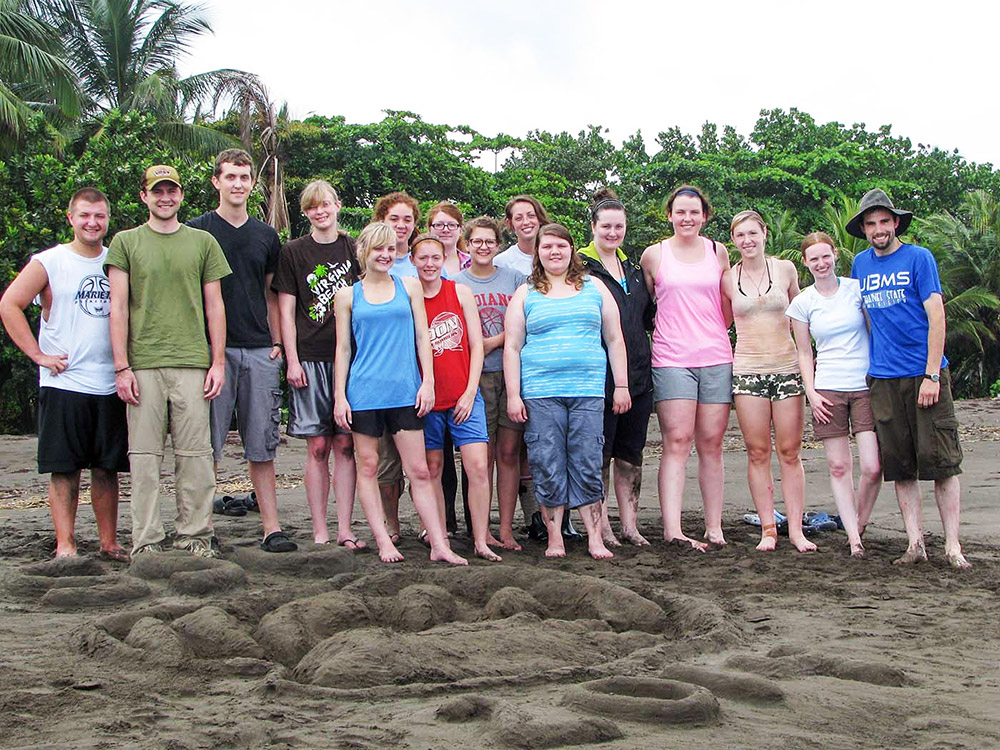June 11, 2014
The four students in front are, from left, Ashley Griffith, Sabrina Brown, Molly Dargavell and Kaytlyn Lewis. In back, from left, are Alex Alley, Lance Rose, Lee Martin, Lindsey Polsley, Kaylee Wright, Maria Frazier, Jordanna Downing, Christa Little, Anna Brown, Jessica Fair, Sarah Minter and husband Logan Minter.
Assistant Professor Sarah Minter, Ph.D., and Adjunct Logan Minter, Ph.D., along with 11 Shawnee State University students conducted research while on a two-week field trip in Costa Rica.
This was the third year SSU has participated in the research in Costa Rica. Students from previous years joined together with this year’s crew in dedicating many hours in fund-raising before they arrived to support the local school.
Students worked with the Canadian Organization for Tropical Education & Rainforest Conservation, a registered Canadian not-for-profit charitable organization. The organization owns and operates Cano Palma Biological Station in the Barro Del Colorado Wildlife Refuge in Costa Rica (www.coterc.org) that provided the SSU researchers the opportunity to study lowland tropical rainforest ecology.
The students had four to five teams out on the beach every night, as well as helping man the mammal, herp (frogs, lizards, snakes, etc.) and bird projects, working at the local school, and conducting their own research projects.
In addition to helping with the base surveys and duties, students had the opportunity to visit the nearby village of San Francisco. This is a small village of approximately 300 people situated in the rainforest. Elementary school children are about one third of the population.
Shawnee State students took supplies and materials for native students at the elementary school, including nature- and science-themed books, pencil cases, colored pencils, puppets, rulers, etc. with $500 donated to the station manager who works closely with the school.
“Altogether, they raised $800 for the school,” Minter said. “We had to take the supplies and money to them because there is no postal system there.”
One of the major projects at the station is the monitoring of the endangered marine turtles that comes to the nearby Playa Norte beach to lay eggs. Students and station staff split into groups and walked the distance of the beach each night. The beach is nearly five miles long and occupied every night by people interested in the conservation of the turtles.
“This is to discourage poaching of the turtle eggs as the turtles come in to nest,” Minter said.
During their night walks, the students often crossed paths with a turtle that is in the middle of nesting. When this occurs the students measure the turtle’s size, check the health of the turtle, count the number of eggs that she lays, and triangulates the nest so that it can be disguised from poachers and still be identified by researchers later on.
Besides measuring and working with sea turtles, students participated in surveys that investigated the local caiman (reptile related to the alligator) populations. They walk transects in the forests at night to look for herps (frogs, lizards, snakes, etc.). Any snakes found are collected and brought back to base for measuring and tagging before being released.
Mammal transects are also monitored and tracks are recorded. Two types of bird surveys are being completed at this time and the students helped with both. Shore bird surveys occur once weekly on the beaches. Within the forest, mist nets are set up and birds are temporarily captured. Once the birds are captured they are weighed, inspected for parasites, and banded before returning to their habitat.
Three of the students — Lee Martin, Jessica Fair, and Jordanna Downing — were working on their own undergraduate research projects while on base. Martin was working with camera traps and mammal tracks; Jessica was investigating butterfly and caterpillar plant interactions; and Jordanna was investigating the water bodies that are used as nursery by a species of poison dart frog that is endemic to the region.
“The experience was unlike anything else I have ever done,” said student Lance Rose.

